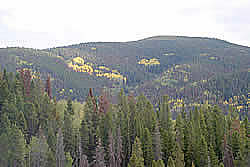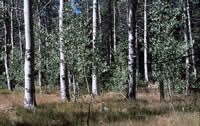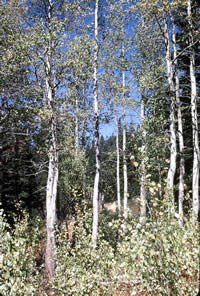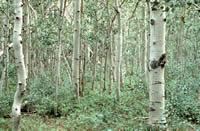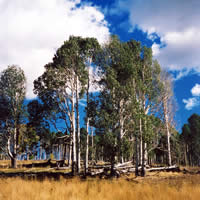USDA Forest Service Celebrating Wildflowers
|
|
|
 |
|
Aspen Decline
Something seems to be happening to the aspens that paint the hills gold every autumn, leaving bald patches across the Rocky Mountain West. Some aspen stands are not recovering from disturbance and naturally regenerating the way they have in the past. The mystery of the aspen decline deepens as it seems to be occurring only in some stands and in some Western states and is not affecting any neighboring trees, though many of these have been affected by mountain pine beetle attacks. Forest scientists are working to figure out what is happening to the aspen groves.
The aspen decline has been most noticeable in southwestern Colorado, northern Arizona, and parts of Utah and Canada, but is also in Idaho, Nevada, Montana, and southern Wyoming. However, different processes or causes may be leading to the various aspen declines across the West. For decades, forest managers have called attention to "aspen decline," a long-term reduction in area of aspen forests. It was considered to be the result of reduced fire frequency, which allowed succession to conifer forests; and heavy browsing by large ungulates, which prevented the regeneration of aspen in burned or harvested forests. Other researchers, however, say there is no conclusive evidence of a long-term aspen decline when presettlement conditions are considered. For example, some make the case that the number of aspen in Colorado actually has increased in the past century. They point to historical data that indicates widespread disturbance caused by timber harvesting and fires in the late 1800s and early 1900s may have enabled aspen to become abundant in the Rocky Mountains. Natural processes of succession should result in a reduction of aspen as that cohort matures and dies. Other studies have suggested that aspen decline occurs at local scales, but readily persists at larger landscape scales. Fun FactAspens often reproduce from root suckers instead of seeds.
More recently, however, "sudden aspen decline" (SAD) has been reported. As of 2007, widespread, severe, rapid dieback and mortality had affected about 13 percent of the aspen in Colorado. SAD is different from what is traditionally referred to as aspen decline. It is occurring on a landscape scale, versus the stand-level changes that are typically noted with aspen forest related to disturbance and succession. The mortality is rapidly occurring over a few years, versus the typical changes occurring over decades. In addition, pathogens and insects associated with SAD are different from those usually associated with aspen mortality in Colorado. Evidence indicates that warm drought conditions earlier in the decade played a primary inciting role, that certain stand and site factors predisposed aspen to damage, and that the pathogens and insects are killing stressed trees. An accelerated dieback of aspen was also observed across northern Arizona following two defoliation events and several years of drought. A secondary disease and/or insect was found to be associated with the dying trees as well, including canker fungi, wood borers, and clear wing moths. Aspen regeneration by suckering was observed after the dieback, but little of it remained after heavy ungulate browsing. The extensive dieback and ungulate browsing of the aspen suckers is expected to result in forest type conversions, from aspen to conifer, in many of these sites across the state. Aspen reproduce primarily by sprouting from root systems, rather than spreading seeds. Each "clone" can live hundreds or even thousands of years. A stem may die, but beneath the soil, the root sends out fresh shoots, and the cycle begins again. The aspen stands with dying trees do not seem to produce shoots to replace old trees as they normally would, which may be related to years of drought that inflicted deep damage. NOTE: The video content presented here requires JavaScript to be enabled and the latest version of the Adobe Flash Player. If you are you using a browser with JavaScript disabled please enable it now. Otherwise, please update your version of the free Flash Player. Watch aspens be replaced by conifers. How do know if an aspen grove is a healthy?
A healthy aspen grove includes sprouts, saplings (middle-aged trees), and mature trees. The best rule of thumb to know for figuring out whether an aspen grove is healthy is whether you can see through it. If you can see through an aspen grove, check whether the grove is missing the aspen sprout and/or the sapling layer. If either of these layers are missing and there are mature aspen trees, grass, shrubs, and/or young conifers present, the replacement of the aspen grove may be underway. The grass, shrubs, and/or conifers have a competitive advantage, in the absence of disturbance such as fire, as they use valuable resources needed by the aspen sprouts and seedlings, such as sunlight, water, and soil nutrients. If no sprouts or saplings are present and there are only a few mature trees in an aspen grove. The grove is not healthy if it is no longer producing sprouts. Unfortunately, it may be just a matter of time before this aspen grove dies off and disappears from the landscape. The key to maintaining a healthy aspen grove are a continuing source of sprouts. New sprouts are the best indicator that the grove is healthy. |
|
| NOTE: PDF format links require the Adobe Acrobat Reader to view. | |
| top | Disclaimers | FOIA | Privacy Policy | Quality of Information | Photo Credits & Use |
Location: http://www.fs.fed.us/wildflowers/communities/aspen/decline.shtml
Last modified: Tuesday, 24-Jun-2008 21:53:14 EDT
